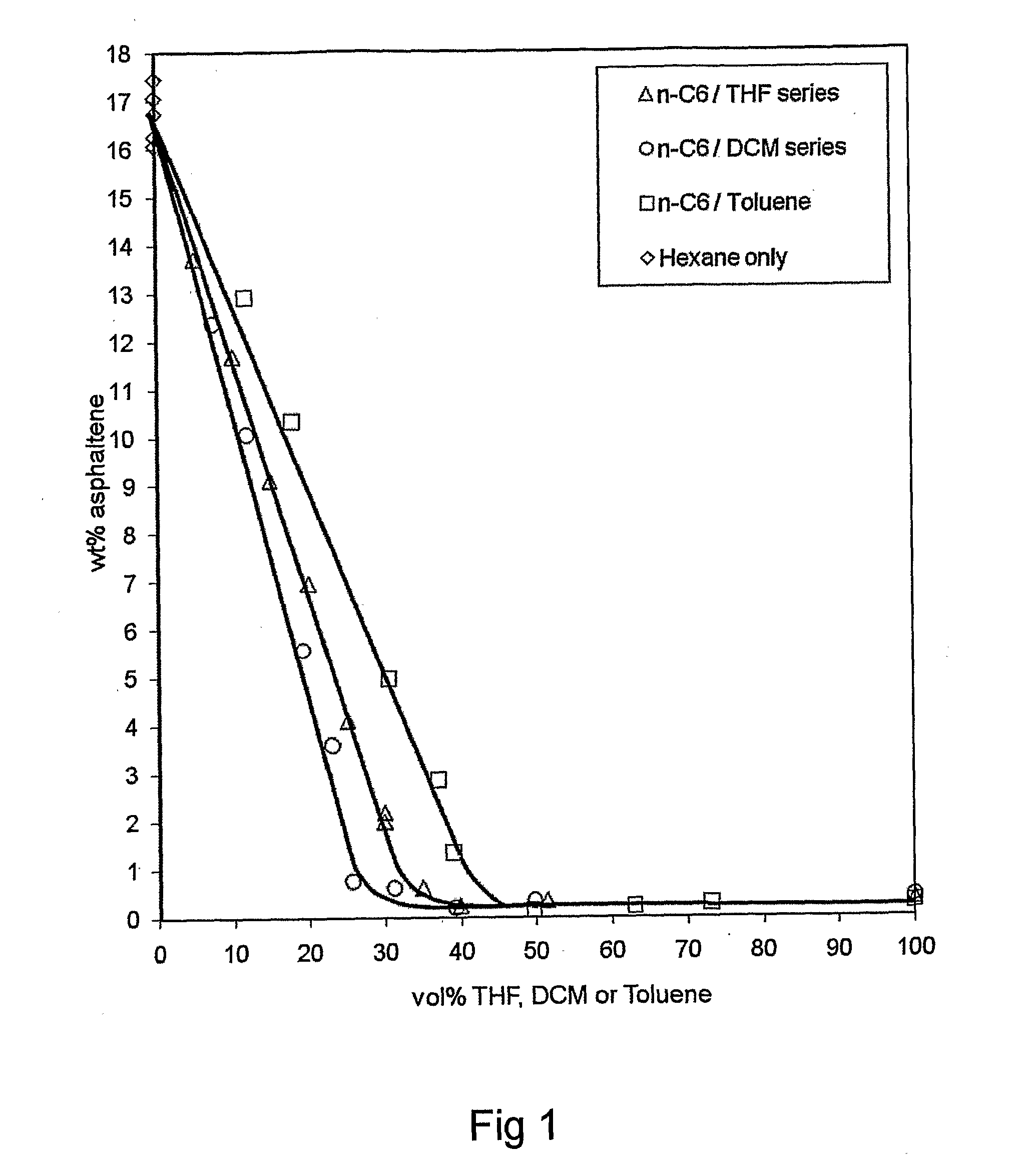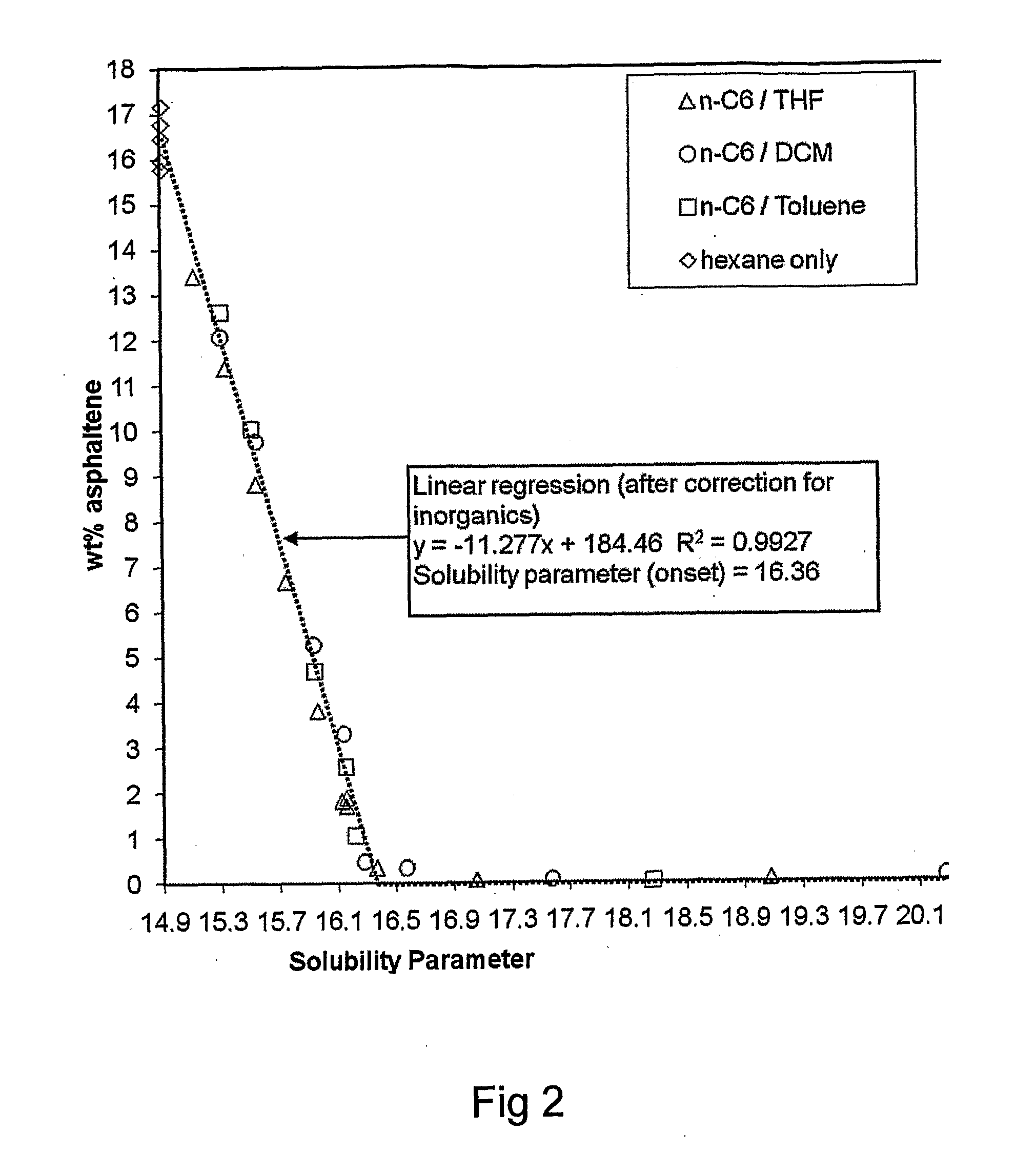Forecasting asphaltic precipitation
a technology of asphaltic precipitation and forecasting, which is applied in the direction of bulk chemical production, instruments, borehole/well accessories, etc., can solve the problems of large quantities of diluent, large solvent requirements, and large cost, and the formation damage during oil recovery has been recognised as a significant issu
- Summary
- Abstract
- Description
- Claims
- Application Information
AI Technical Summary
Benefits of technology
Problems solved by technology
Method used
Image
Examples
example 1
[0107]It is assumed, in order to illustrate the possibility of making a forecast of precipitation, that the heavy crude oil whose properties were found by the experiments above is to be extracted by injecting nonane into the reservoir and that the reservoir temperature is 25° C. Nonane has a solubility parameter of 15.4 MPa1 / 2 at 25° C. If it is assumed that the oil becomes diluted with nonane in proportions of 30 volumes nonane to 1 volume oil, the Hildebrand solubility parameter for the added liquid will be given by
δmix=φoilδoil+φnonaneδnonane
where φoil is 1 / 31 and φnonane is 30 / 31. The solubility parameter for such a mixture of oil and nonane calculates as δmix=15.5 MPa1 / 2 and from FIG. 3 the percentage asphaltene precipitated is forecast to be 10.5% by weight.
example 2
[0108]This example also refers to the same heavy oil as in Example 1. As mentioned earlier, on FIG. 3, a curve taking in the data point for supercritical carbon dioxide at 2200 psi and 40 C is given by the formula (X)
y=−1.693(δmix)2+41.863δmix−231.2 (X)
where y is percent asphaltic precipitation and δmix is the solubility parameter of the oil-plus-diluent mixture. Using this formula, it is possible to predict the percentage asphaltic separation from the heavy crude oil when the viscosity reducing diluent is supercritical carbon dioxide at 4500 psi pressure and 40° C.
[0109]Under these conditions the Hildebrand solubility parameter of supercritical carbon dioxide is 14.3 MPa1 / 2 read off from curves published by Allada which have been mentioned earlier. Assuming that dilution is 40:1, the solubility parameter of the mixture is given by:
δmix=1 / 40×δoil+40 / 41×δCO2=14.4 MPa1 / 2
[0110]Substituting this in the formula above, asphaltene precipitation is predicted to be 20.5%.
example 3
[0111]It is assumed that a hypothetical medium crude oil has been found by experimentation to have the following values at its reservoir temperature of 30° C.:[0112]δonset-crit 16.2 MPa1 / 2
δoil 18.0 MPa1 / 2
[0113]Asphaltene precipitated by hexane: 6 wt %.
[0114]A graph of asphaltene precipitation against solubility parameter of the overall mixture takes the form of a straight line given by the equation
y=−3.75δmix+60.75 (XI)
where δmix=the solubility parameter of the oil-plus-diluent mixture and y is the amount of asphaltic precipitate, as a percentage of the crude oil, when equilibrium is reached.
[0115]It is decided to make a viscosity reducing diluent mixture from two constituents which are both refinery distillates. These are[0116](i) a mixture of alkanes having solubility parameter of 14.5 at 30° C.[0117](ii) a mixture of aromatics, having solubility parameter of 17.8 at 30° C.
[0118]The solubility parameter for mixtures containing 10%, 20%, 30% and 40% aromatics by volume is calcul...
PUM
 Login to View More
Login to View More Abstract
Description
Claims
Application Information
 Login to View More
Login to View More - R&D
- Intellectual Property
- Life Sciences
- Materials
- Tech Scout
- Unparalleled Data Quality
- Higher Quality Content
- 60% Fewer Hallucinations
Browse by: Latest US Patents, China's latest patents, Technical Efficacy Thesaurus, Application Domain, Technology Topic, Popular Technical Reports.
© 2025 PatSnap. All rights reserved.Legal|Privacy policy|Modern Slavery Act Transparency Statement|Sitemap|About US| Contact US: help@patsnap.com



